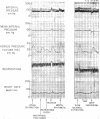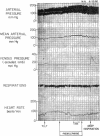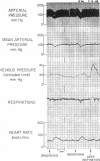Abstract
Although baroreceptor stimulation produced by marked alterations in arterial pressure has been shown to produce reflex changes in venous tone in animals, the effects on venous tone in man of altering arterial pressure within the physiologic range have not been clear. In six subjects, venous tone did not change when mean arterial pressure was raised by 25-40 mm Hg, although heart rate fell reflexly by 40%. Venous tone remained constant in 10 subjects when arterial pressure was lowered. This contrasted to the sustained rise in forearm vascular resistance and the persistent tachycardia that occurred. However, 12 subjects continued to respond to these interventions by transient venoconstriction. To eliminate possible emotional influences on venous tone due to the experimental intervention, venous responses were studied before and during general anesthesia in five of these subjects. In contrast to the response before anesthesia, an equivalent fall in arterial pressure during anesthesia no longer evoked a venoconstrictor response. Venous reactivity and the baroreceptor reflex arc remained intact during anesthesia, since venous tone always rose after a deep inspiration, and tachycardia always accompanied the fall in arterial pressure. It is concluded that changes in arterial pressure in the physiologic range in man do not induce measurable reflex alterations in venous tone, and that the increases sometimes seen with decreases in arterial pressure appear to be due to extraneous psychic factors.
Full text
PDF
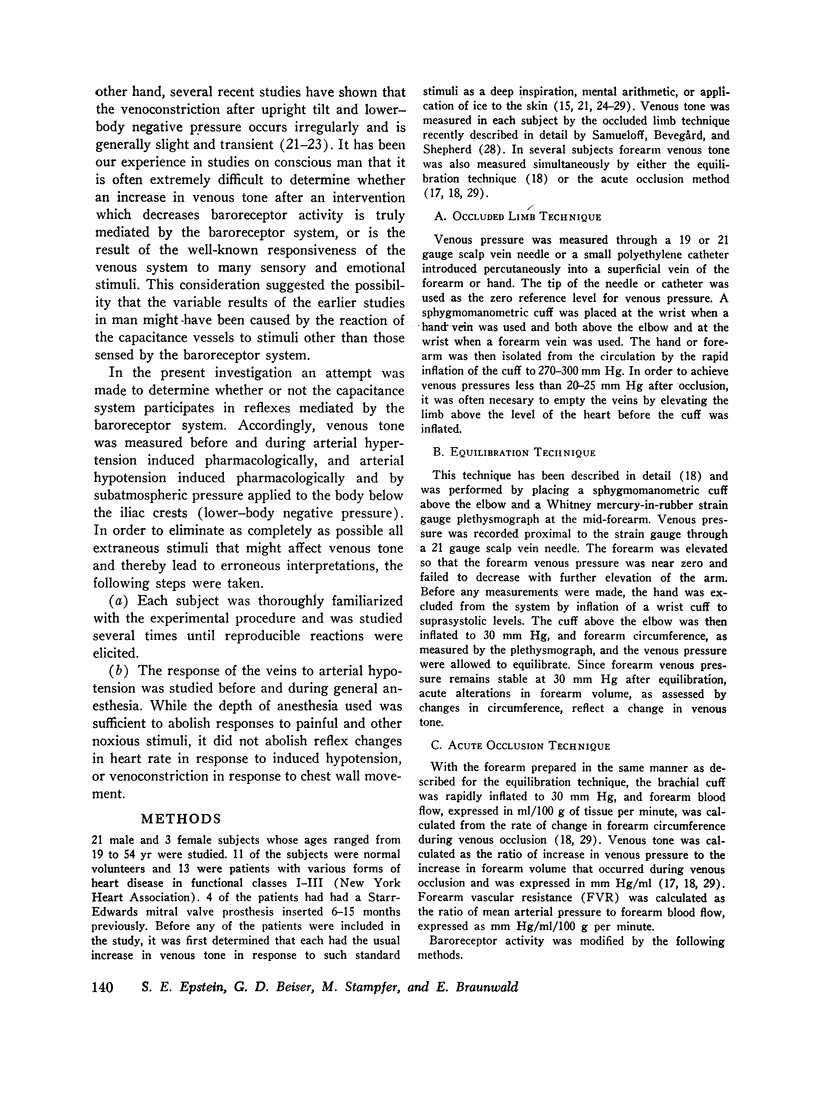
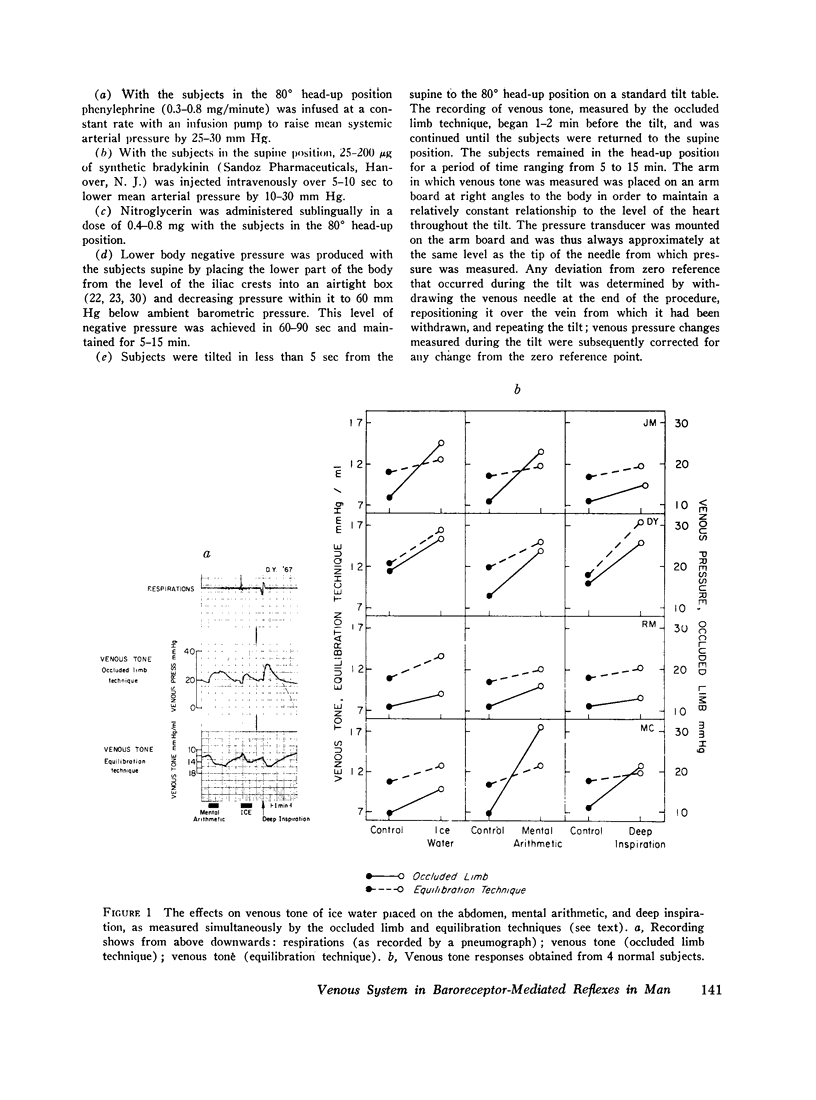
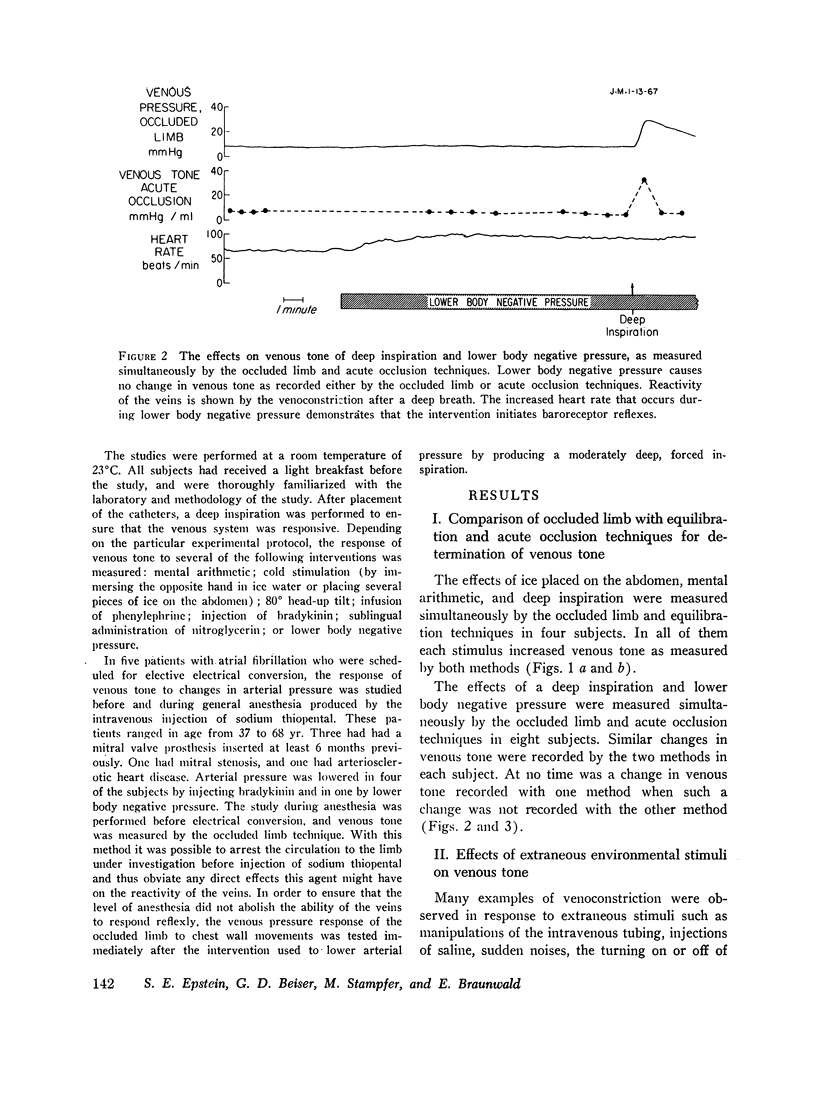
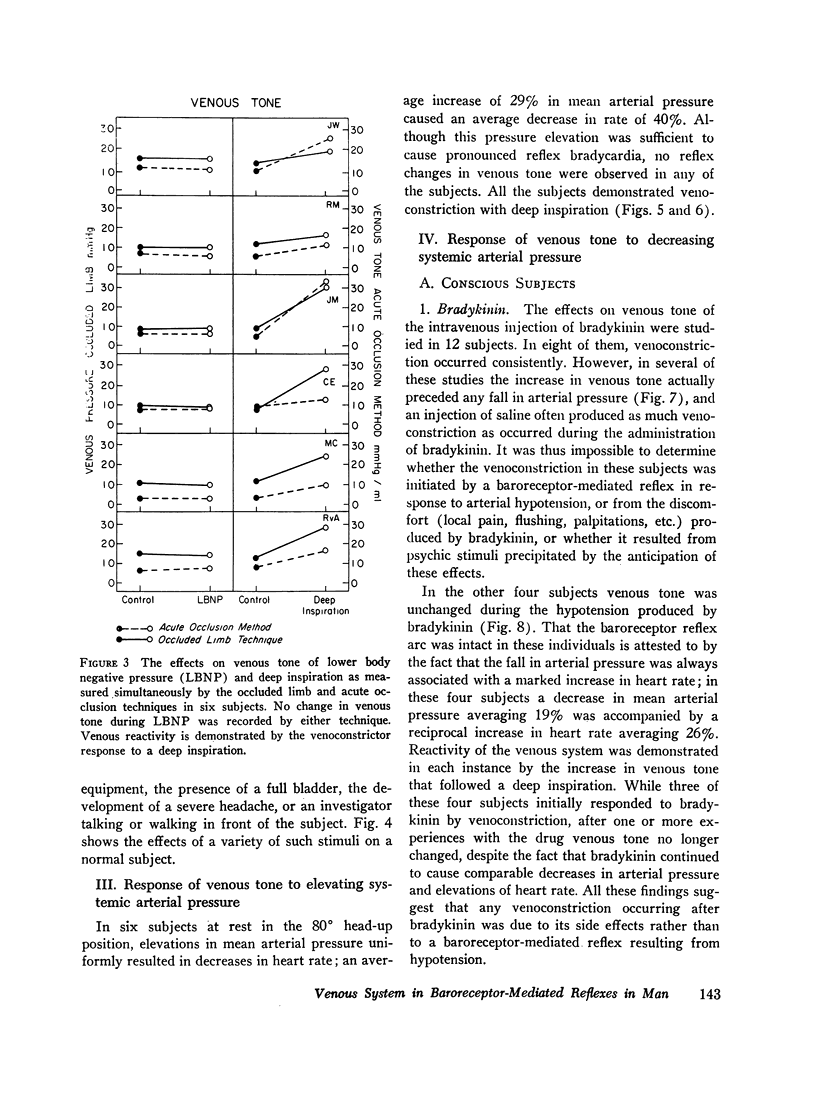
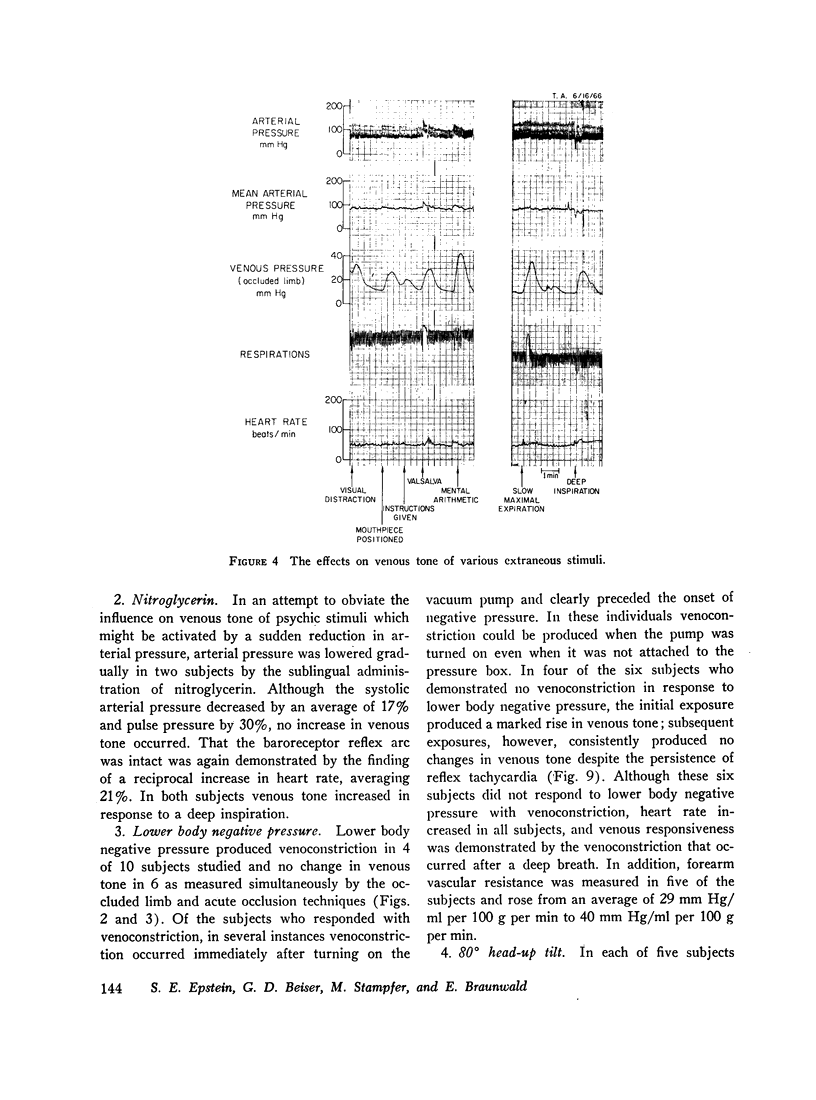

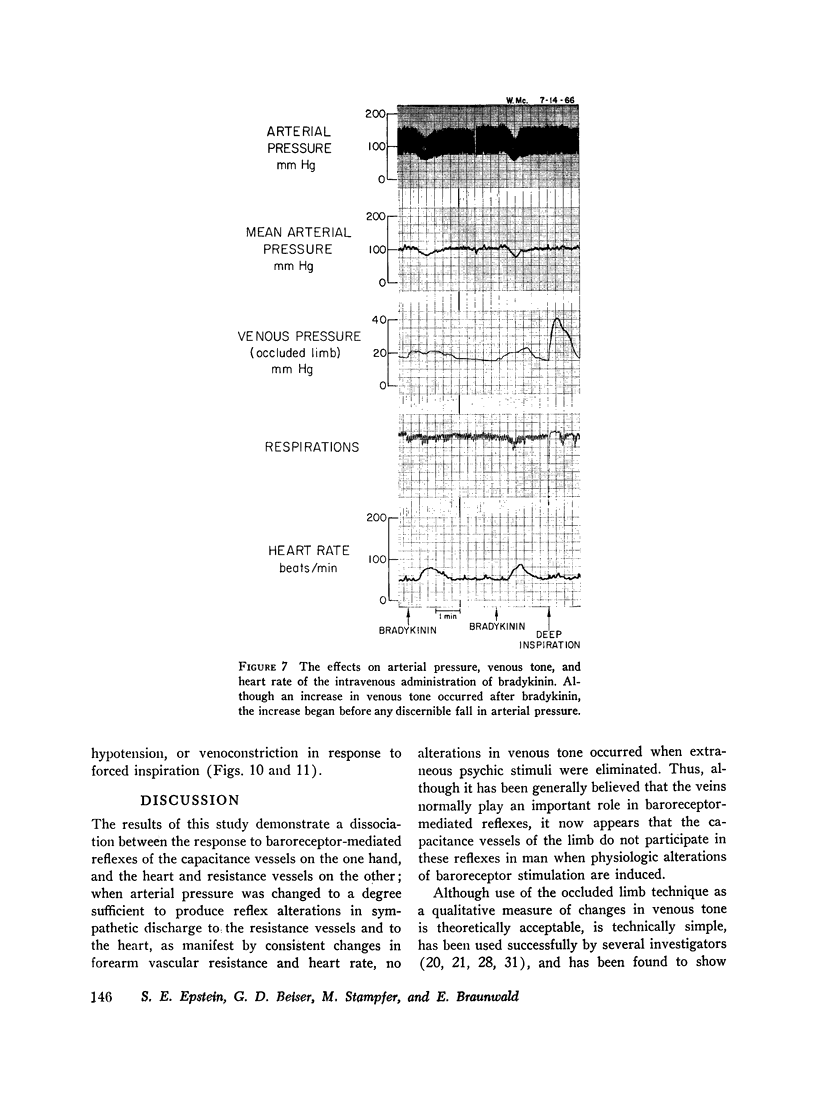
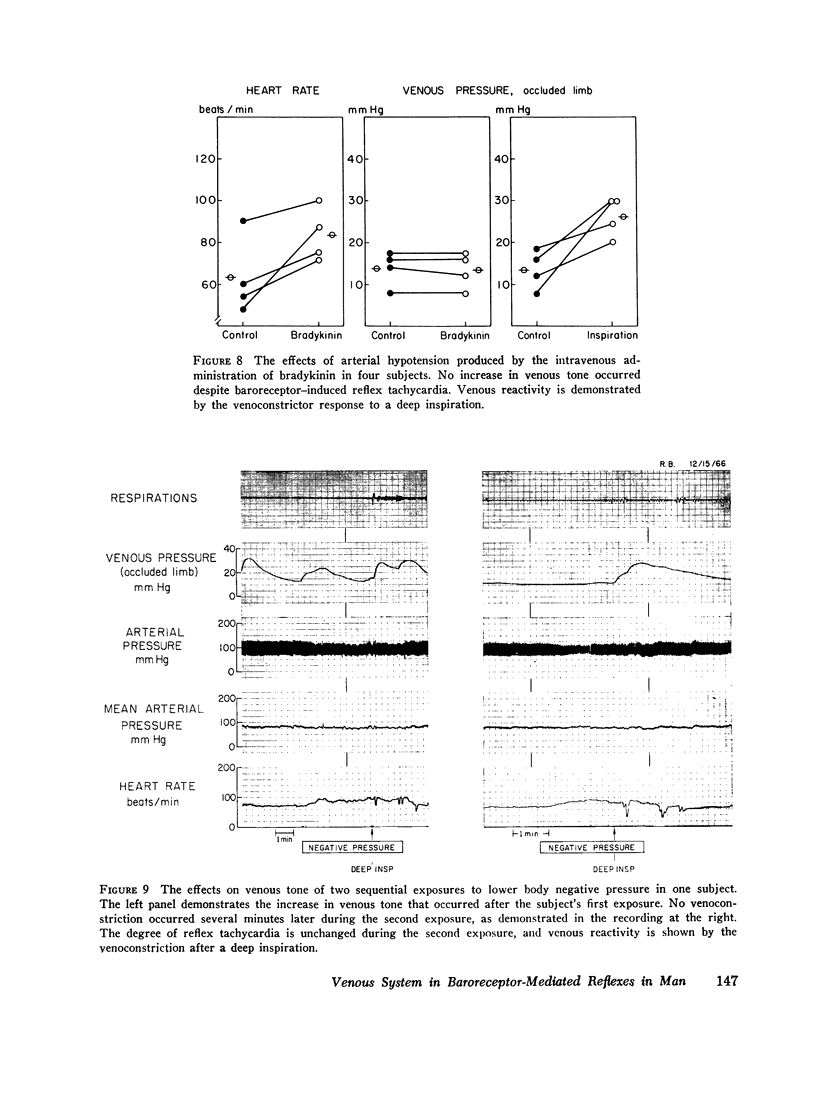
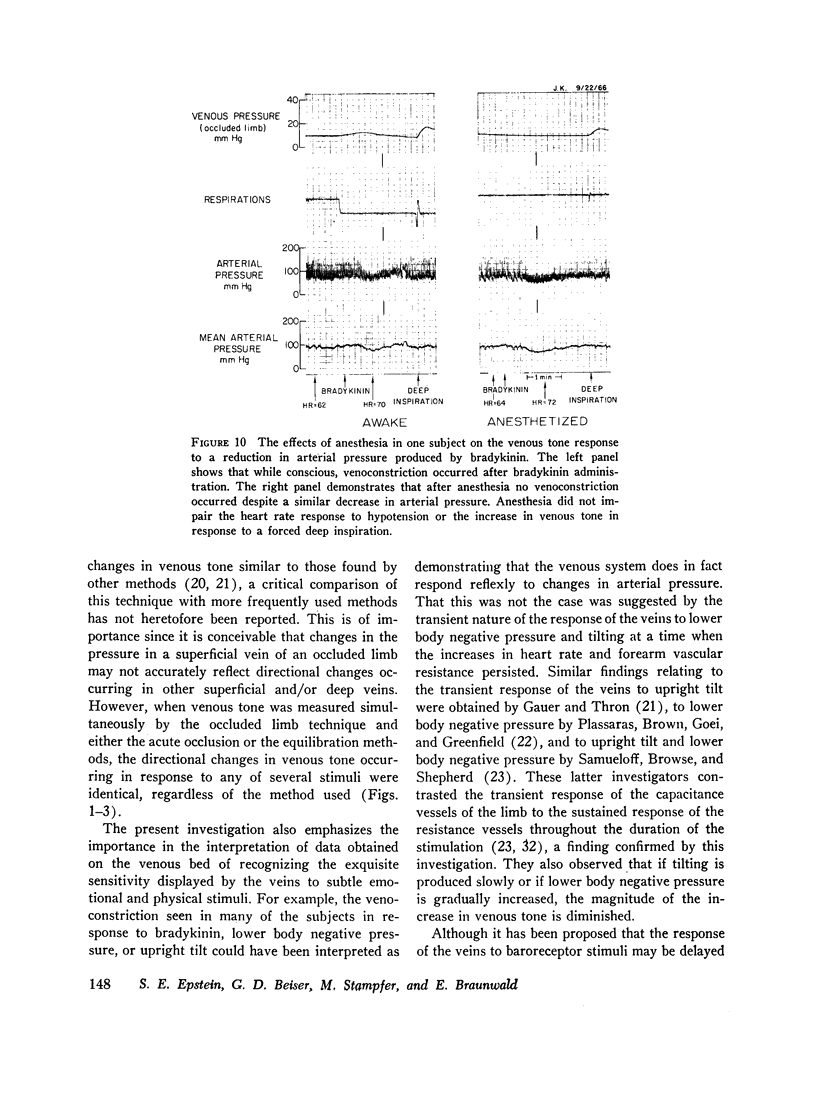
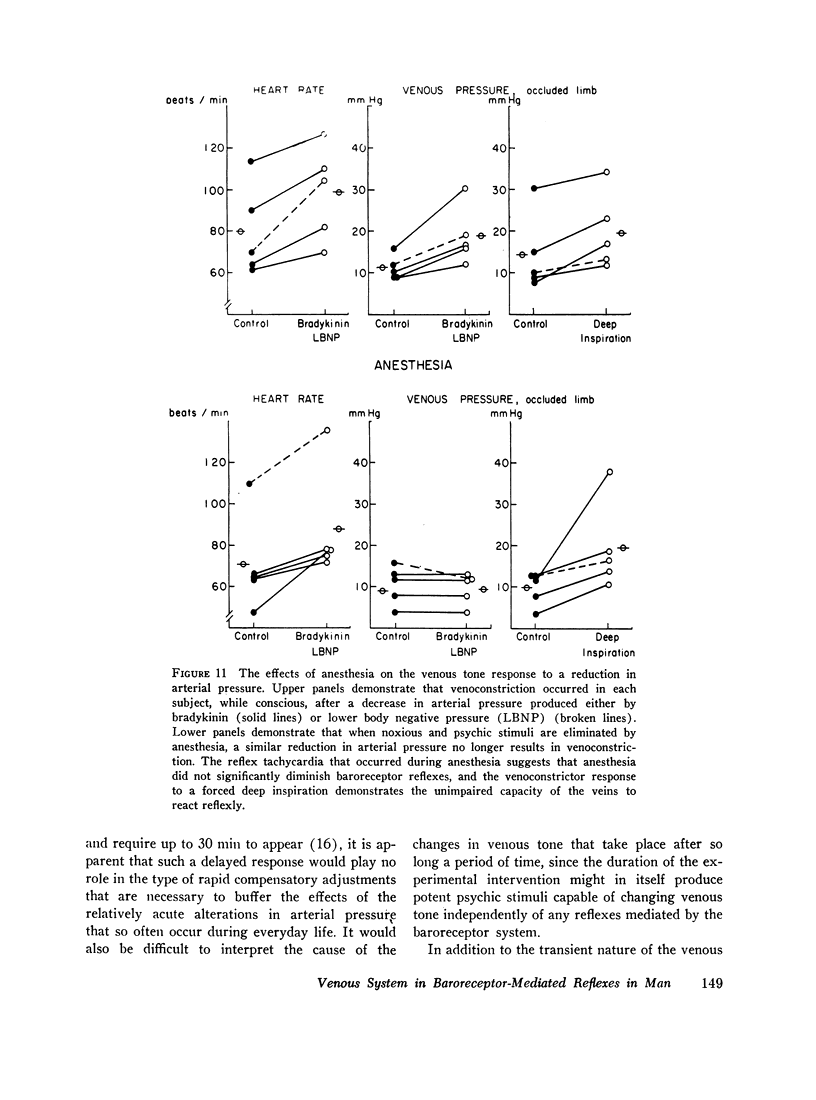
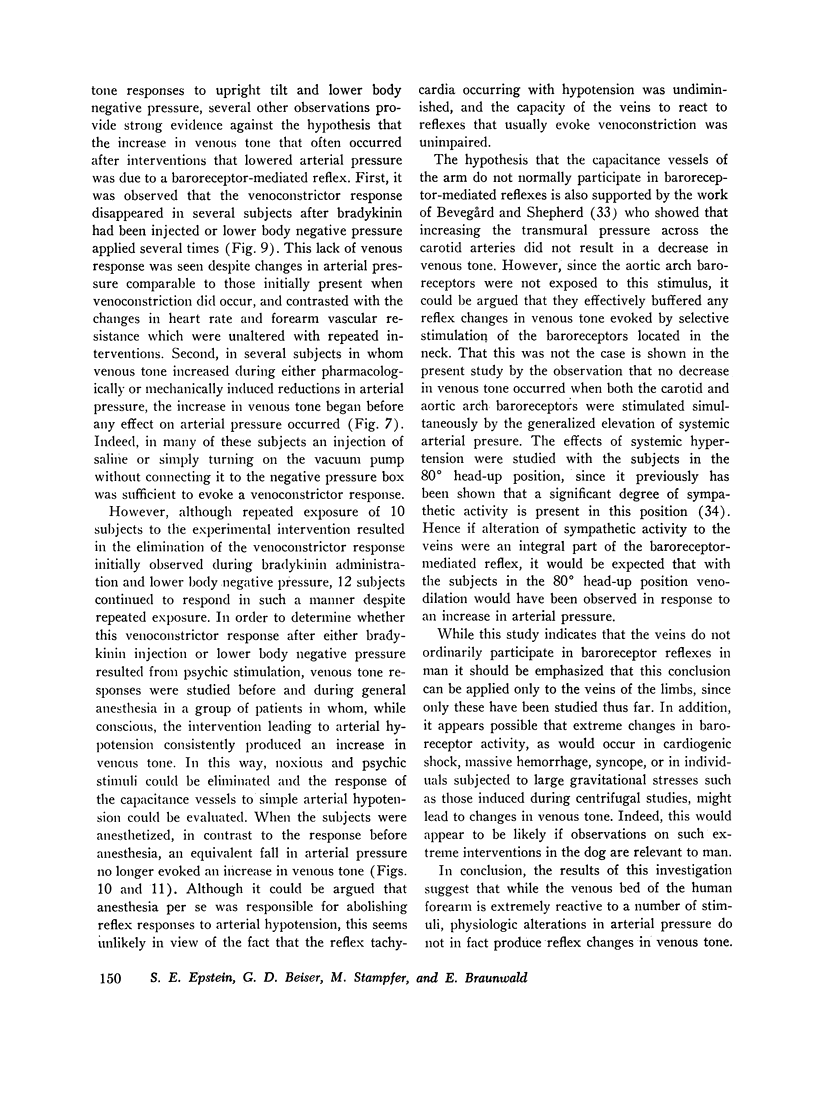
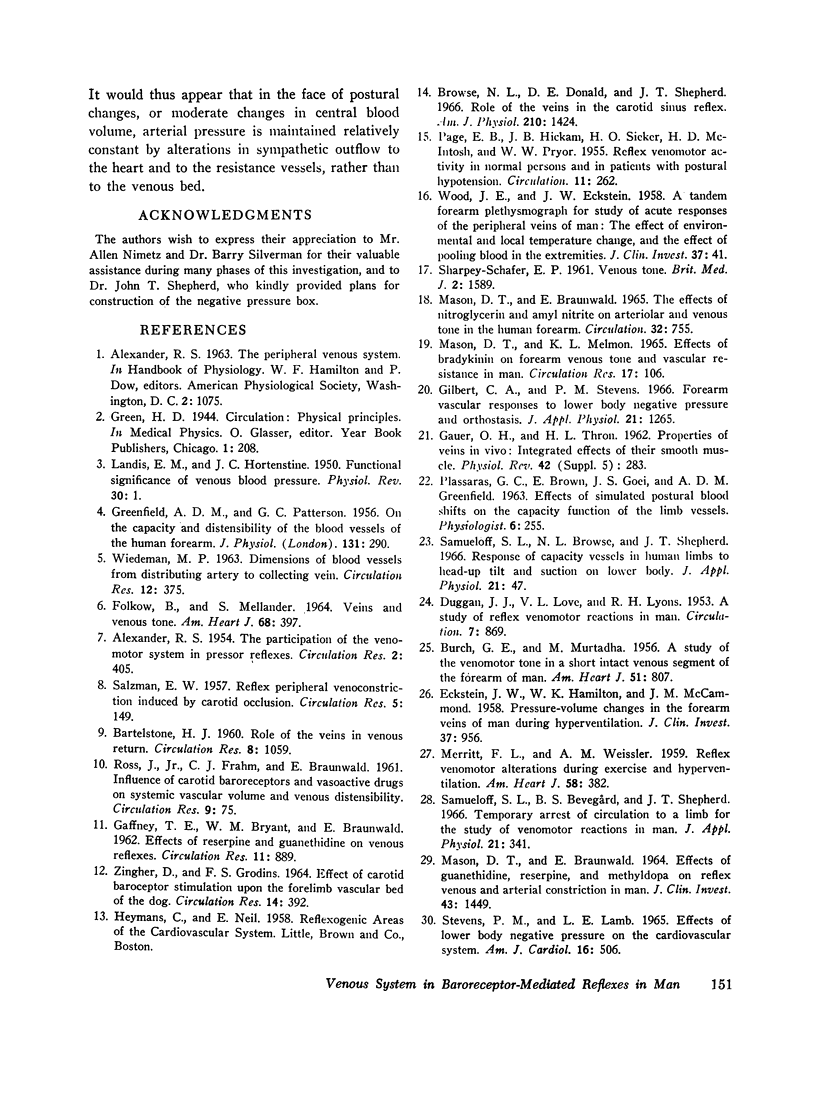
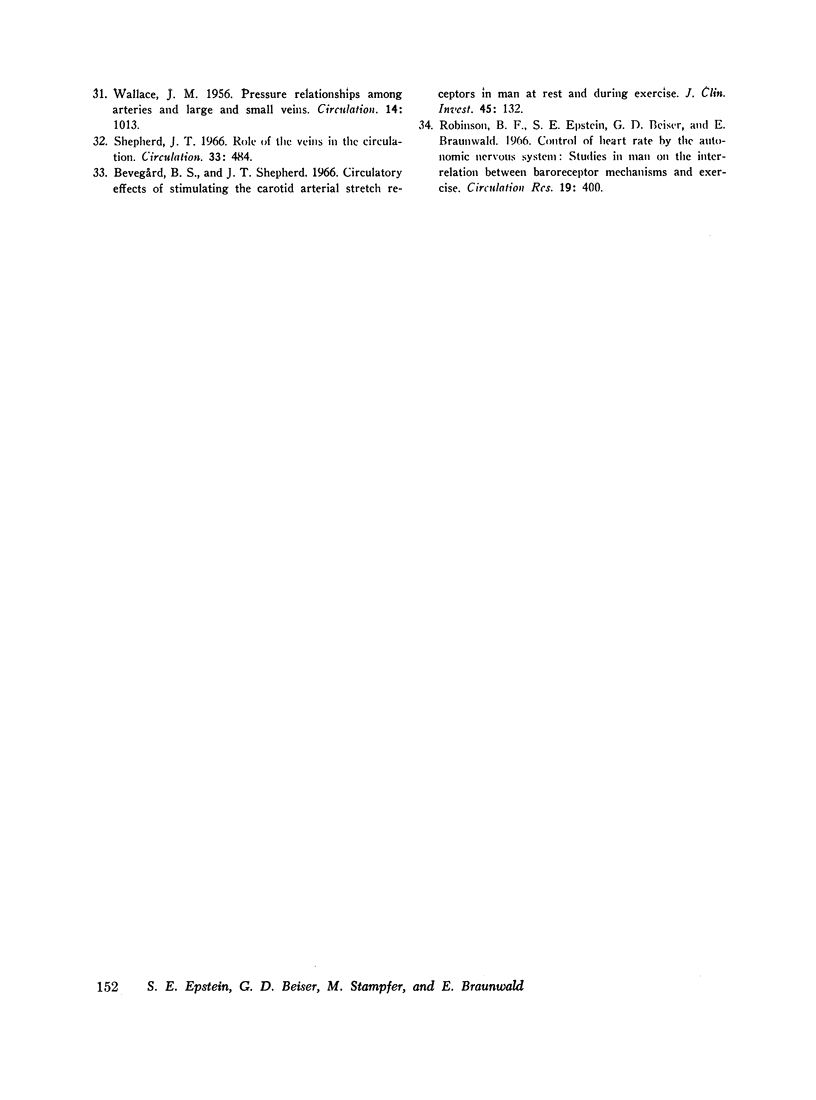
Images in this article
Selected References
These references are in PubMed. This may not be the complete list of references from this article.
- ALEXANDER R. S. The participation of the venomotor system in pressor reflexes. Circ Res. 1954 Sep;2(5):405–409. doi: 10.1161/01.res.2.5.405. [DOI] [PubMed] [Google Scholar]
- BARTELSTONE H. J. Role of the veins in venous retunr. Circ Res. 1960 Sep;8:1059–1076. doi: 10.1161/01.res.8.5.1059. [DOI] [PubMed] [Google Scholar]
- BURCH G. E., MURTADHA M. A study of the venomotor tone in a short intact venous segment of the forearm of man. Am Heart J. 1956 Jun;51(6):807–828. doi: 10.1016/0002-8703(56)90225-3. [DOI] [PubMed] [Google Scholar]
- Bevegård B. S., Shepherd J. T. Circulatory effects of stimulating the carotid arterial stretch receptors in man at rest and during exercise. J Clin Invest. 1966 Jan;45(1):132–142. doi: 10.1172/JCI105317. [DOI] [PMC free article] [PubMed] [Google Scholar]
- Browse N. L., Donald D. E., Shepherd J. T. Role of the veins in the carotid sinus reflex. Am J Physiol. 1966 Jun;210(6):1424–1434. doi: 10.1152/ajplegacy.1966.210.6.1424. [DOI] [PubMed] [Google Scholar]
- DUGGAN J. J., LOVE V. L., LYONS R. H. A study of reflex venomotor reactions in man. Circulation. 1953 Jun;7(6):869–873. doi: 10.1161/01.cir.7.6.869. [DOI] [PubMed] [Google Scholar]
- ECKSTEIN J. W., HAMILTON W. K., McCAMMOND J. M. Pressure-volume changes in the forearm veins of man during hyperventilation. J Clin Invest. 1958 Jul;37(7):956–961. doi: 10.1172/JCI103690. [DOI] [PMC free article] [PubMed] [Google Scholar]
- FOLKOW B., MELLANDER S. VEINS AND VENOUS TONE. Am Heart J. 1964 Sep;68:397–408. doi: 10.1016/0002-8703(64)90308-4. [DOI] [PubMed] [Google Scholar]
- GAFFNEY T. E., BRYANT W. M., BRAUNWALD E. Effects of reserpine and guanethidine on venous reflexes. Circ Res. 1962 Nov;11:889–894. doi: 10.1161/01.res.11.5.889. [DOI] [PubMed] [Google Scholar]
- GAUER O. H., THRON H. L. Properties of veins in vivo: integrated effects of their smooth muscle. Physiol Rev Suppl. 1962 Jul;5:283–308. [PubMed] [Google Scholar]
- GREENFIELD A. D., PATTERSON G. C. On the capacity and distensibility of the blood vessels of the human forearm. J Physiol. 1956 Feb 28;131(2):290–306. doi: 10.1113/jphysiol.1956.sp005463. [DOI] [PMC free article] [PubMed] [Google Scholar]
- Gilbert C. A., Stevens P. M. Forearm vascular responses to lower body negative pressure and orthostasis. J Appl Physiol. 1966 Jul;21(4):1265–1272. doi: 10.1152/jappl.1966.21.4.1265. [DOI] [PubMed] [Google Scholar]
- LANDIS E. M., HORTENSTINE J. C. Functional significance of venous blood pressure. Physiol Rev. 1950 Jan;30(1):1–32. doi: 10.1152/physrev.1950.30.1.1. [DOI] [PubMed] [Google Scholar]
- MASON D. T., BRAUNWALD E. EFFECTS OF GUANETHIDINE, RESERPINE, AND METHYLDOPA ON REFLEX VENOUS AND ARTERIAL CONSTRICTION IN MAN. J Clin Invest. 1964 Jul;43:1449–1463. doi: 10.1172/JCI105021. [DOI] [PMC free article] [PubMed] [Google Scholar]
- MASON D. T., MELMON K. L. EFFECTS OF BRADYKININ ON FOREARM VENOUS TONE AND VASCULAR RESISTANCE IN MAN. Circ Res. 1965 Aug;17:106–113. doi: 10.1161/01.res.17.2.106. [DOI] [PubMed] [Google Scholar]
- Mason D. T., Braunwald E. The effects of nitroglycerin and amyl nitrite on arteriolar and venous tone in the human forearm. Circulation. 1965 Nov;32(5):755–766. doi: 10.1161/01.cir.32.5.755. [DOI] [PubMed] [Google Scholar]
- PAGE E. B., HICKAM J. B., SIEKER H. O., McINTOSH H. D., PRYOR W. W. Reflex venomotor activity in normal persons and in patients with postural hypotension. Circulation. 1955 Feb;11(2):262–270. doi: 10.1161/01.cir.11.2.262. [DOI] [PubMed] [Google Scholar]
- Robinson B. F., Epstein S. E., Beiser G. D., Braunwald E. Control of heart rate by the autonomic nervous system. Studies in man on the interrelation between baroreceptor mechanisms and exercise. Circ Res. 1966 Aug;19(2):400–411. doi: 10.1161/01.res.19.2.400. [DOI] [PubMed] [Google Scholar]
- SALZMAN E. W. Reflex peripheral venoconstriction induced by carotid occlusion. Circ Res. 1957 Mar;5(2):149–152. doi: 10.1161/01.res.5.2.149. [DOI] [PubMed] [Google Scholar]
- SHARPEY-SCHAFER E. P. Venous tone. Br Med J. 1961 Dec 16;2(5267):1589–1595. doi: 10.1136/bmj.2.5267.1589. [DOI] [PMC free article] [PubMed] [Google Scholar]
- Samueloff S. L., Bevegård B. S., Shepherd J. T. Temporary arrest of circulation to a limb for the study of venomotor reactions in man. J Appl Physiol. 1966 Jan;21(1):341–346. doi: 10.1152/jappl.1966.21.1.341. [DOI] [PubMed] [Google Scholar]
- Samueloff S. L., Browse N. L., Shepherd J. T. Response of capacity vessels in human limbs to head-up tilt and suction on lower body. J Appl Physiol. 1966 Jan;21(1):47–54. doi: 10.1152/jappl.1966.21.1.47. [DOI] [PubMed] [Google Scholar]
- Shepherd J. T. Role of the veins in the circulation. Circulation. 1966 Mar;33(3):484–491. doi: 10.1161/01.cir.33.3.484. [DOI] [PubMed] [Google Scholar]
- Stevens P. M., Lamb L. E. Effects of lower body negative pressure on the cardiovascular system. Am J Cardiol. 1965 Oct;16(4):506–515. doi: 10.1016/0002-9149(65)90027-5. [DOI] [PubMed] [Google Scholar]
- WIEDEMAN M. P. Dimensions of blood vessels from distributing artery to collecting vein. Circ Res. 1963 Apr;12:375–378. doi: 10.1161/01.res.12.4.375. [DOI] [PubMed] [Google Scholar]
- WOOD J. E., ECKSTEIN J. W. A tandem foream plethysmograph for study of acute responses of the peripheral veins of man: the effect of environmental and local temperature change, and the effect of pooling blood in the extremities. J Clin Invest. 1958 Jan;37(1):41–50. doi: 10.1172/JCI103583. [DOI] [PMC free article] [PubMed] [Google Scholar]
- ZINGHER D., GRODINS F. S. EFFECT OF CAROTID BAROCEPTOR STIMULATION UPON THE FORELIMB VASCULAR BED OF THE DOG. Circ Res. 1964 May;14:392–399. doi: 10.1161/01.res.14.5.392. [DOI] [PubMed] [Google Scholar]




